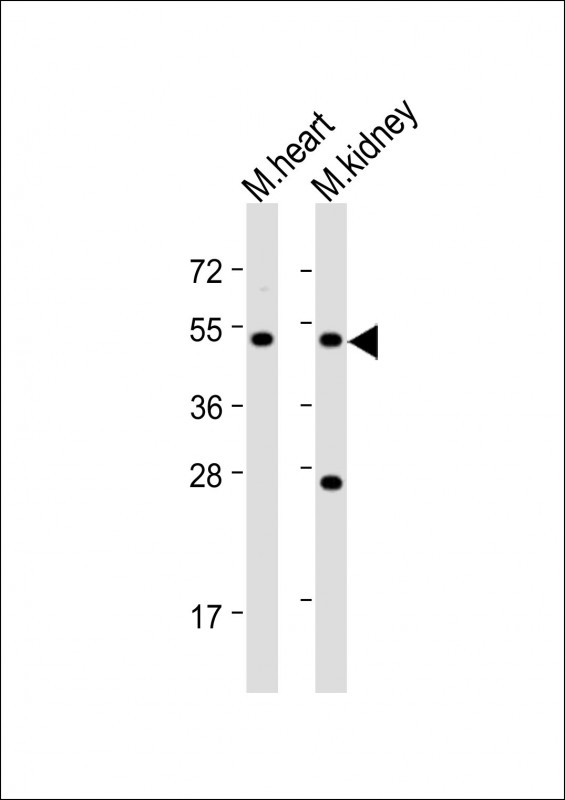
| WB | 1/2000 | Human,Mouse,Rat |
| IF | 咨询技术 | Human,Mouse,Rat |
| IHC | 咨询技术 | Human,Mouse,Rat |
| ICC | 技术咨询 | Human,Mouse,Rat |
| FCM | 咨询技术 | Human,Mouse,Rat |
| Elisa | 咨询技术 | Human,Mouse,Rat |
| Aliases | Phosphatidylinositol glycan anchor biosynthesis class U protein, Cell division cycle protein 91-like 1, Protein CDC91-like 1, GPI transamidase component PIG-U, PIGU, CDC91L1 |
| Entrez GeneID | 128869 |
| WB Predicted band size | 50.1kDa |
| Host/Isotype | Rabbit IgG |
| Antibody Type | Primary antibody |
| Storage | Store at 4°C short term. Aliquot and store at -20°C long term. Avoid freeze/thaw cycles. |
| Species Reactivity | Human, Mouse, Rat |
| Immunogen | This PIGU antibody is generated from a rabbit immunized with a KLH conjugated synthetic peptide between 102-134 amino acids from human PIGU. |
+ +
以下是关于PIGU (N-Term)抗体的3篇参考文献,包含文献名称、作者及摘要概述:
---
1. **文献名称**: *Autoantibodies against the N-terminal domain of PIGU in paraneoplastic pemphigus*
**作者**: Hashimoto T, Ishii N, et al.
**摘要**: 本研究报道了在副肿瘤性天疱疮(PNP)患者血清中检测到针对PIGU蛋白N端结构域的自身抗体。通过免疫沉淀和Western blot分析,证实这些抗体与GPI生物合成途径中的PIGU蛋白特异性结合,可能参与GPI锚定蛋白的自身免疫反应机制。
2. **文献名称**: *Monoclonal antibody targeting the N-terminus of PIGU for diagnosis of autoimmune diseases*
**作者**: Zhang Y, Wang L, et al.
**摘要**: 研究团队开发了一种针对PIGU蛋白N端表位的单克隆抗体,用于检测自身免疫疾病患者的血清样本。实验表明,该抗体在免疫荧光和ELISA中具有高灵敏度和特异性,为PNP等疾病的诊断提供了新工具。
3. **文献名称**: *Structural and functional analysis of PIGU in GPI-anchor biosynthesis*
**作者**: Kinoshita T, Fujita M.
**摘要**: 本文通过基因敲除和抗体阻断实验,揭示了PIGU在GPI锚定蛋白合成中的关键作用。研究发现,针对PIGU N端的抗体可抑制其与其他GPAT复合体成员的相互作用,导致GPI锚定缺陷,进而影响细胞膜蛋白定位。
---
以上文献均聚焦于PIGU蛋白N端的功能及抗体应用,涉及疾病机制、诊断工具开发及分子机制研究。如需具体文献来源,建议通过PubMed或Google Scholar检索标题或作者进一步获取全文。
The PIGU (N-Term) antibody is designed to target the N-terminal region of the PIGU protein, a key component of the glycosylphosphatidylinositol (GPI) anchor biosynthesis pathway. GPI anchors are essential for attaching certain proteins to cell membranes, facilitating their localization and function. PIGU, also known as phosphatidylinositol glycan anchor biosynthesis class U, is part of a multi-subunit complex in the endoplasmic reticulum (ER) that catalyzes the transfer of GPI anchors to precursor proteins. This post-translational modification is critical for the biological activity of numerous cell surface proteins, including enzymes, receptors, and adhesion molecules.
Mutations in the PIGU gene have been linked to inherited GPI deficiency disorders, which can manifest as developmental delays, neurological abnormalities, and other systemic issues. The N-terminal region of PIGU is believed to play a structural or regulatory role in the GPI transamidase complex, interacting with other subunits like PIGS, PIGT, and PIGK. Researchers use the PIGU (N-Term) antibody in applications such as Western blotting, immunoprecipitation, and immunofluorescence to study PIGU expression, subcellular localization, and interactions under physiological or pathological conditions. Its specificity for the N-terminus ensures detection of full-length PIGU, aiding investigations into protein stability, mutations, or truncations associated with disease. Validation often includes knockout cell lines to confirm antibody reliability.
×